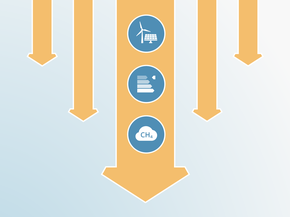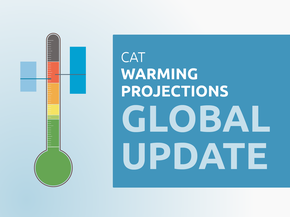Targets
Target Overview
In 2022, Viet Nam submitted its updated NDC, increasing its unconditional target to reduce GHG emissions by 15.8% below business-as-usual levels (BAU) by 2030 including LULUCF, compared to 9% in the previous NDC. Conditional on international support, this target will be further increased to 43.5% below BAU including LULUCF, higher than the previous conditional target of 27% below BAU. The conditional target of 43.5% includes the unconditional target of 15.8%; thus, the additional ambition attributable to international support is 27.7 percentage points (43.5% minus 15.8%) from 2030 BAU emissions.
The updated unconditional and conditional targets translate to 878 and 629 MtCO2e in 2030, or 12% and 37% below BAU, respectively, excluding the land use and forestry sector.
The updated NDC claims that the new targets are aligned to fulfill Viet Nam’s commitments made at COP26, but it is not a true progression in scaling up climate action, as it is still aligned with 4°C of warming and reaching the target requires no additional effort beyond current policies. Notably, at COP26, Viet Nam committed to reach net zero by 2050 along with additional pledges related to a coal phase-out and methane emission reductions.
In its updated NDC, Viet Nam has transparently presented the financial requirements to achieve its unconditional and conditional targets.
The CAT rates Viet Nam’s targets as "Critically Insufficient."
| VIET NAM - Main climate targets |
|---|
| 2030 unconditional NDC target | |||
|---|---|---|---|
| Formulation of target in NDC | 15.8% reduction below BAU in 2030 | ||
| Absolute emissions level in 2030 excl. LULUCF |
878 MtCO2e [206% above 2010] |
||
| Status | Submitted in November 2022 | ||
| 2030 conditional NDC target | |||
|---|---|---|---|
| Formulation of target in NDC | 43.5% reduction below BAU in 2030 | ||
| Absolute emissions level in 2030 excl. LULUCF |
629 MtCO2e [119% above 2010] |
||
| Status | Submitted in November 2022 | ||
| Net zero & other long-term targets | |||
|---|---|---|---|
| Formulation of target | Net zero by 2050 | ||
| Absolute emissions level in 2050 excl. LULUCF | 189 MtCO2e | ||
| Status | Included in the decision document approving the National Climate Change Strategy in July 2022. | ||
NDC updates
Viet Nam submitted its updated Nationally Determined Contribution (NDC) to the UNFCCC in November 2022 (Viet Nam Government 2022e). This is the second update provided by Viet Nam, which also provided an update in 2020.
In this latest NDC update, Viet Nam increased its unconditional target to a 15.8% reduction below BAU in 2030 and a 43.5% reduction with international support.
While numerically stronger, the targets are still “Critically insufficient” and while Viet Nam is on track to achieving the unconditional target with its current policies, the target will not drive further climate action. The CAT assessment therefore does not consider Viet Nam’s NDC update to be stronger than its previous submission.
In line with its previous NDC, the updated NDC has transparently provided a sectoral breakdown of targets and policies. Viet Nam has also provided the detailed financial requirements to implement those policies to achieve the targets. Most of these measures are already laid out in the National Climate Change Strategy to 2050 (Viet Nam Government 2022c).
The updated NDC has also put forward a detailed implementation plan of the targets by improving policies and institutions, creating awareness and community engagement, capacity and technological development, financial mobility and enhanced international cooperation. A framework for monitoring and evaluation of the targets, which was presented in the previous NDC, is now part of revised Law on Environmental Protection 2020 through a new government regulation.
The BAU pathway in the updated NDC remains unchanged from previous 2020 NDC. The BAU scenario is developed based on a “medium economic development” forecast without clearly mentioning if it considers the dip in economic activities during the pandemic.
While Viet Nam has made some improvements to the structure of its NDC, it continues with incomplete gas coverage. Emissions of F-gases are negligible in Viet Nam and the updated NDC does not include full greenhouse gas coverage, excluding NF3, PFCs and SF6. These were stated as included in the first NDC; however, they are not mentioned in the technical report that underlies the first NDC.
| VIET NAM — History of NDC updates | First NDC (2016) | 2020 NDC update | 2022 NDC update |
|---|---|---|---|
| 1.5°C compatible |
|
|
|
| Stronger target | N/A |
|
|
| Economy-wide coverage |
|
|
|
| Fixed/absolute target |
|
|
|
| VIET NAM | First NDC (2016) | 2020 NDC update | 2022 NDC update |
|---|---|---|---|
| Formulation of target in NDC |
Unconditional target 8% reduction below BAU in 2030 (excluding industrial process emissions) Conditional target 25% reduction below BAU in 2030 (excluding industrial process emissions) |
Unconditional target 9% reduction below BAU in 2030 (including industrial process emissions) Conditional target 27% reduction below BAU in 2030 (including industrial process emissions) |
Unconditional target 15.8% reduction below BAU in 2030 (including industrial process emissions) Conditional target 43.5% reduction below BAU in 2030 (including industrial process emissions) |
| Absolute emissions level in 2030 excl. LULUCF |
Unconditional target 936 MtCO2e** Conditional target 840 MtCO2e** |
Unconditional target 918 MtCO2e Conditional target 835 MtCO2e |
Unconditional target 878 MtCO2e Conditional target 629 MtCO2e |
| Emissions compared to 2010 excl. LULUCF |
Unconditional target 226% above 2010 emissions Conditional target 193% above 2010 emissions |
Unconditional target 220% above 2010 emissions Conditional target 191% above 2010 emissions |
Unconditional target 206% above 2010 emissions Conditional target 119% above 2010 emissions |
| CAT rating |
Overall rating:* Critically insufficient |
Unconditional target against fair share Critically insufficient Conditional target against modelled domestic pathways Critically insufficient |
Unconditional target against fair share Critically insufficient Conditional target against modelled domestic pathways Critically insufficient |
| Sector coverage | Excluding industry | Economy-wide | Economy-wide |
| Separate target for LULUCF |
Yes Unconditional contribution: Forest cover will increase to 45% |
Yes Unconditional target: Increase LULUCF emissions removal by 9 MtCO2e above BAU levels. Conditional target: Increase LULUCF emissions by 21 MtCO2e below BAU levels. |
Yes Unconditional target: Increase LULUCF emissions removal by 33 MtCO2e above BAU levels and increase forest cover to 42%. Conditional target: Increase LULUCF emissions removal by 47 MtCO2e above BAU levels. |
| Gas coverage | Six greenhouse gases (CO2, CH4, N20, HFCs, PFCs, SF6) | CO2, CH4, N20, HFCs | CO2, CH4, N20, HFCs |
| Target type | Emissions reduction from BAU | Emissions reduction from BAU | Emissions reduction from BAU |
* Before September 2021, all CAT ratings were based exclusively on fair share and only assessed a country’s target.
** We have updated these figures to include the latest 2030 BAU estimates to allow for comparability across targets.
Analysis of earlier NDC developments:
- 11 December 2020: Viet Nam did not increase ambition
CAT rating of targets
The CAT rates NDC targets against what a fair contribution to achieving the Paris Agreement’s long-term temperature goal would be as well as against indicative national emissions from global least-cost pathways that achieve the Paris Agreement’s temperature goal (called modelled domestic pathways).
Viet Nam has put forward two targets in its NDC: one that it will achieve using its own resources (15.8% GHG emissions reduction from BAU) and one that is conditional on international support (43.5% GHG emissions reduction from BAU). We rate the country’s unconditional target against its fair share contribution and its conditional target against modelled domestic pathways.
We estimate that Viet Nam’s conditional target would result in an emissions level of 629 MtCO2e (excluding LULUCF) in 2030, which we rate as "Critically Insufficient." This rating is based on Viet Nam’s modelled domestic pathway for limiting warming to 1.5°C.
The “Critically insufficient” rating indicates that Viet Nam’s conditional target reflects minimal to no action and is not at all consistent with limiting warming to 1.5°C. If all countries were to follow Viet Nam’s approach, warming would exceed 4°C.
We estimate that Viet Nam’s unconditional target would result in an emissions level of 878 MtCO2e (excluding LULUCF) in 2030, which we rate as "Critically insufficient." This rating is based on Viet Nam’s fair share contribution to limit global warming to 1.5°C.
The “Critically insufficient” rating indicates that Viet Nam’s unconditional target reflects minimal to no action and is not at all consistent with limiting warming to 1.5°C. Viet Nam’s target is not in line with any interpretation of fairness. If all countries were to follow Viet Nam’s approach, warming would exceed 4°C.
Net zero and other long-term target(s)
Viet Nam announced a target to achieve net zero by 2050 target during the COP26 World Leaders' Summit in 2021. In July 2022, Viet Nam reiterated its commitment to reach net zero in the decision approving its National Climate Change Strategy, aimed at guiding its planning to achieve net zero by 2050. Viet Nam’s net zero target is conditional on international financial support. The CAT rates Viet Nam’s target as “Average”.
The full net zero target analysis can be found here.
Further analysis
Latest publications
Stay informed
Subscribe to our newsletter




